Shutong Feng
Emotionally Intelligent Task-oriented Dialogue Systems: Architecture, Representation, and Optimisation
Jul 02, 2025Abstract:Task-oriented dialogue (ToD) systems are designed to help users achieve specific goals through natural language interaction. While recent advances in large language models (LLMs) have significantly improved linguistic fluency and contextual understanding, building effective and emotionally intelligent ToD systems remains a complex challenge. Effective ToD systems must optimise for task success, emotional understanding and responsiveness, and precise information conveyance, all within inherently noisy and ambiguous conversational environments. In this work, we investigate architectural, representational, optimisational as well as emotional considerations of ToD systems. We set up systems covering these design considerations with a challenging evaluation environment composed of a natural-language user simulator coupled with an imperfect natural language understanding module. We propose \textbf{LUSTER}, an \textbf{L}LM-based \textbf{U}nified \textbf{S}ystem for \textbf{T}ask-oriented dialogue with \textbf{E}nd-to-end \textbf{R}einforcement learning with both short-term (user sentiment) and long-term (task success) rewards. Our findings demonstrate that combining LLM capability with structured reward modelling leads to more resilient and emotionally responsive ToD systems, offering a practical path forward for next-generation conversational agents.
CASE-Bench: Context-Aware Safety Evaluation Benchmark for Large Language Models
Jan 24, 2025


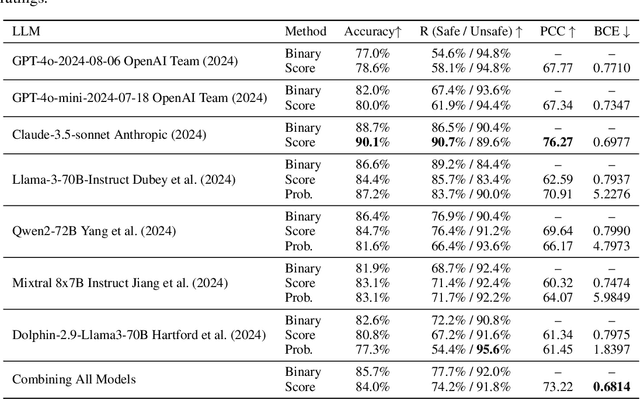
Abstract:Aligning large language models (LLMs) with human values is essential for their safe deployment and widespread adoption. Current LLM safety benchmarks often focus solely on the refusal of individual problematic queries, which overlooks the importance of the context where the query occurs and may cause undesired refusal of queries under safe contexts that diminish user experience. Addressing this gap, we introduce CASE-Bench, a Context-Aware Safety Evaluation Benchmark that integrates context into safety assessments of LLMs. CASE-Bench assigns distinct, formally described contexts to categorized queries based on Contextual Integrity theory. Additionally, in contrast to previous studies which mainly rely on majority voting from just a few annotators, we recruited a sufficient number of annotators necessary to ensure the detection of statistically significant differences among the experimental conditions based on power analysis. Our extensive analysis using CASE-Bench on various open-source and commercial LLMs reveals a substantial and significant influence of context on human judgments (p<0.0001 from a z-test), underscoring the necessity of context in safety evaluations. We also identify notable mismatches between human judgments and LLM responses, particularly in commercial models within safe contexts.
Learning from Noisy Labels via Self-Taught On-the-Fly Meta Loss Rescaling
Dec 17, 2024



Abstract:Correct labels are indispensable for training effective machine learning models. However, creating high-quality labels is expensive, and even professionally labeled data contains errors and ambiguities. Filtering and denoising can be applied to curate labeled data prior to training, at the cost of additional processing and loss of information. An alternative is on-the-fly sample reweighting during the training process to decrease the negative impact of incorrect or ambiguous labels, but this typically requires clean seed data. In this work we propose unsupervised on-the-fly meta loss rescaling to reweight training samples. Crucially, we rely only on features provided by the model being trained, to learn a rescaling function in real time without knowledge of the true clean data distribution. We achieve this via a novel meta learning setup that samples validation data for the meta update directly from the noisy training corpus by employing the rescaling function being trained. Our proposed method consistently improves performance across various NLP tasks with minimal computational overhead. Further, we are among the first to attempt on-the-fly training data reweighting on the challenging task of dialogue modeling, where noisy and ambiguous labels are common. Our strategy is robust in the face of noisy and clean data, handles class imbalance, and prevents overfitting to noisy labels. Our self-taught loss rescaling improves as the model trains, showing the ability to keep learning from the model's own signals. As training progresses, the impact of correctly labeled data is scaled up, while the impact of wrongly labeled data is suppressed.
Local Topology Measures of Contextual Language Model Latent Spaces With Applications to Dialogue Term Extraction
Aug 07, 2024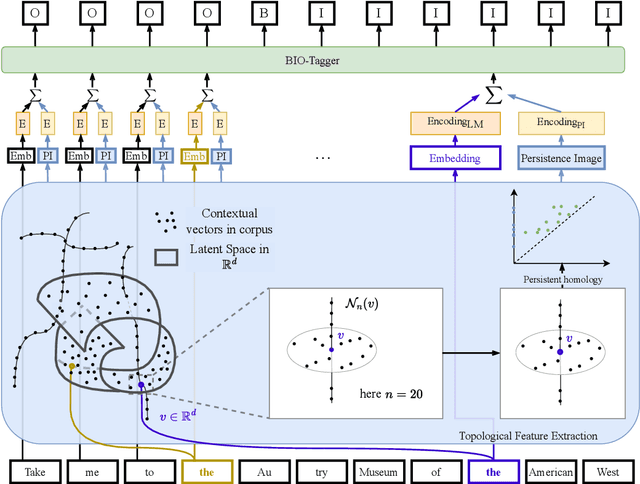

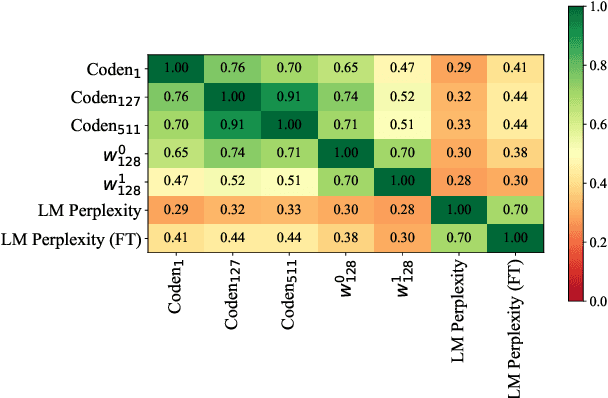

Abstract:A common approach for sequence tagging tasks based on contextual word representations is to train a machine learning classifier directly on these embedding vectors. This approach has two shortcomings. First, such methods consider single input sequences in isolation and are unable to put an individual embedding vector in relation to vectors outside the current local context of use. Second, the high performance of these models relies on fine-tuning the embedding model in conjunction with the classifier, which may not always be feasible due to the size or inaccessibility of the underlying feature-generation model. It is thus desirable, given a collection of embedding vectors of a corpus, i.e., a datastore, to find features of each vector that describe its relation to other, similar vectors in the datastore. With this in mind, we introduce complexity measures of the local topology of the latent space of a contextual language model with respect to a given datastore. The effectiveness of our features is demonstrated through their application to dialogue term extraction. Our work continues a line of research that explores the manifold hypothesis for word embeddings, demonstrating that local structure in the space carved out by word embeddings can be exploited to infer semantic properties.
Infusing Emotions into Task-oriented Dialogue Systems: Understanding, Management, and Generation
Aug 05, 2024

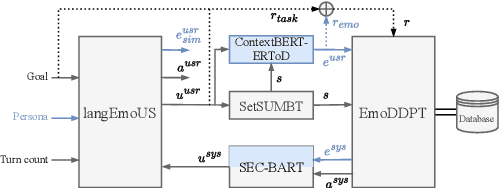
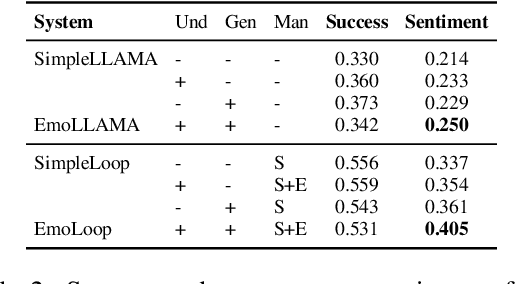
Abstract:Emotions are indispensable in human communication, but are often overlooked in task-oriented dialogue (ToD) modelling, where the task success is the primary focus. While existing works have explored user emotions or similar concepts in some ToD tasks, none has so far included emotion modelling into a fully-fledged ToD system nor conducted interaction with human or simulated users. In this work, we incorporate emotion into the complete ToD processing loop, involving understanding, management, and generation. To this end, we extend the EmoWOZ dataset (Feng et al., 2022) with system affective behaviour labels. Through interactive experimentation involving both simulated and human users, we demonstrate that our proposed framework significantly enhances the user's emotional experience as well as the task success.
Speech-based Slot Filling using Large Language Models
Nov 13, 2023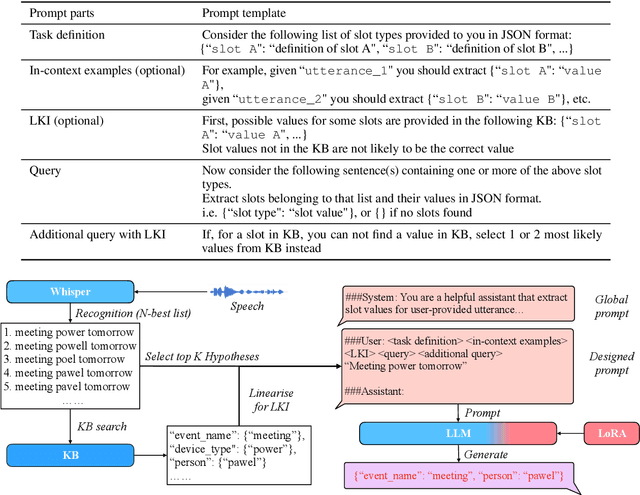

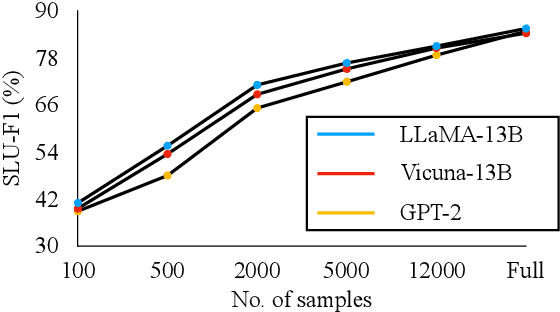
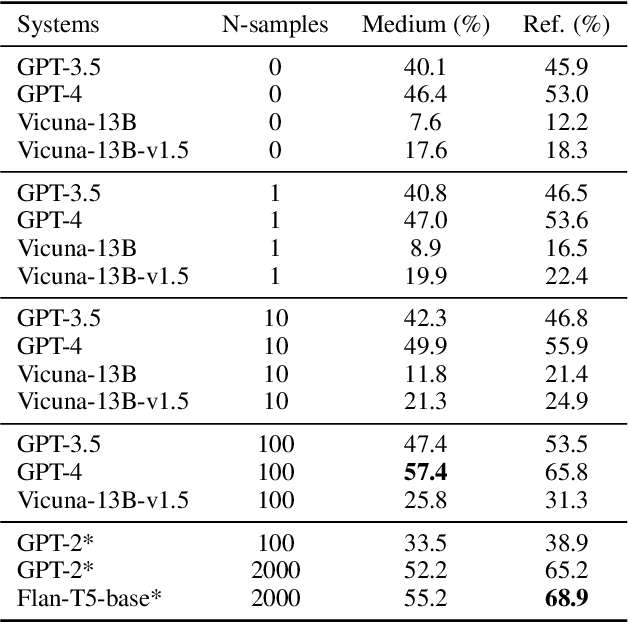
Abstract:Recently, advancements in large language models (LLMs) have shown an unprecedented ability across various language tasks. This paper investigates the potential application of LLMs to slot filling with noisy ASR transcriptions, via both in-context learning and task-specific fine-tuning. Dedicated prompt designs and fine-tuning approaches are proposed to improve the robustness of LLMs for slot filling with noisy ASR transcriptions. Moreover, a linearised knowledge injection (LKI) scheme is also proposed to integrate dynamic external knowledge into LLMs. Experiments were performed on SLURP to quantify the performance of LLMs, including GPT-3.5-turbo, GPT-4, LLaMA-13B and Vicuna-13B (v1.1 and v1.5) with different ASR error rates. The use of the proposed fine-tuning together with the LKI scheme for LLaMA-13B achieved an 8.3% absolute SLU-F1 improvement compared to the strong Flan-T5-base baseline system on a limited data setup.
CAMELL: Confidence-based Acquisition Model for Efficient Self-supervised Active Learning with Label Validation
Oct 13, 2023Abstract:Supervised neural approaches are hindered by their dependence on large, meticulously annotated datasets, a requirement that is particularly cumbersome for sequential tasks. The quality of annotations tends to deteriorate with the transition from expert-based to crowd-sourced labelling. To address these challenges, we present \textbf{CAMELL} (Confidence-based Acquisition Model for Efficient self-supervised active Learning with Label validation), a pool-based active learning framework tailored for sequential multi-output problems. CAMELL possesses three core features: (1) it requires expert annotators to label only a fraction of a chosen sequence, (2) it facilitates self-supervision for the remainder of the sequence, and (3) it employs a label validation mechanism to prevent erroneous labels from contaminating the dataset and harming model performance. We evaluate CAMELL on sequential tasks, with a special emphasis on dialogue belief tracking, a task plagued by the constraints of limited and noisy datasets. Our experiments demonstrate that CAMELL outperforms the baselines in terms of efficiency. Furthermore, the data corrections suggested by our method contribute to an overall improvement in the quality of the resulting datasets.
Affect Recognition in Conversations Using Large Language Models
Sep 22, 2023

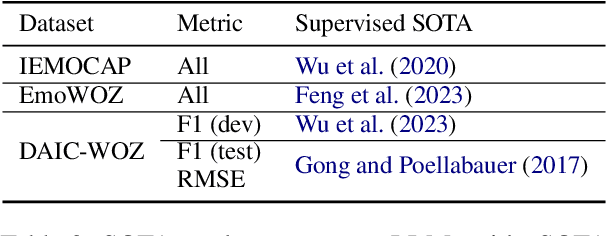

Abstract:Affect recognition, encompassing emotions, moods, and feelings, plays a pivotal role in human communication. In the realm of conversational artificial intelligence (AI), the ability to discern and respond to human affective cues is a critical factor for creating engaging and empathetic interactions. This study delves into the capacity of large language models (LLMs) to recognise human affect in conversations, with a focus on both open-domain chit-chat dialogues and task-oriented dialogues. Leveraging three diverse datasets, namely IEMOCAP, EmoWOZ, and DAIC-WOZ, covering a spectrum of dialogues from casual conversations to clinical interviews, we evaluated and compared LLMs' performance in affect recognition. Our investigation explores the zero-shot and few-shot capabilities of LLMs through in-context learning (ICL) as well as their model capacities through task-specific fine-tuning. Additionally, this study takes into account the potential impact of automatic speech recognition (ASR) errors on LLM predictions. With this work, we aim to shed light on the extent to which LLMs can replicate human-like affect recognition capabilities in conversations.
From Chatter to Matter: Addressing Critical Steps of Emotion Recognition Learning in Task-oriented Dialogue
Aug 24, 2023
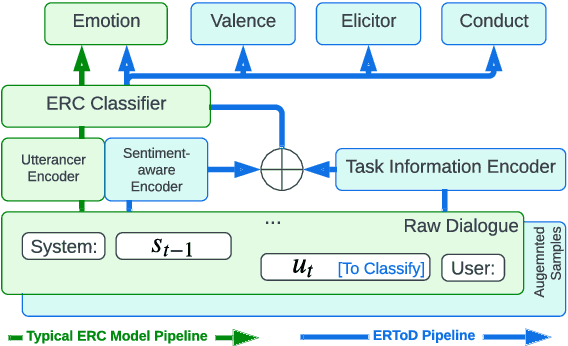
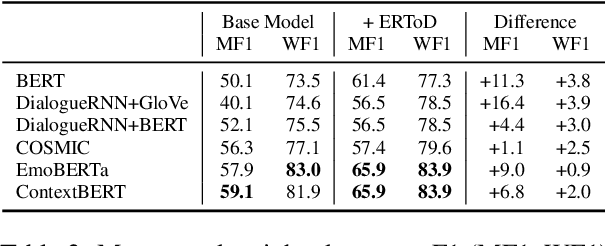
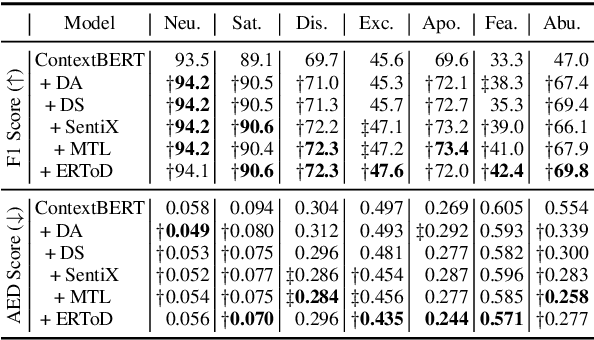
Abstract:Emotion recognition in conversations (ERC) is a crucial task for building human-like conversational agents. While substantial efforts have been devoted to ERC for chit-chat dialogues, the task-oriented counterpart is largely left unattended. Directly applying chit-chat ERC models to task-oriented dialogues (ToDs) results in suboptimal performance as these models overlook key features such as the correlation between emotions and task completion in ToDs. In this paper, we propose a framework that turns a chit-chat ERC model into a task-oriented one, addressing three critical aspects: data, features and objective. First, we devise two ways of augmenting rare emotions to improve ERC performance. Second, we use dialogue states as auxiliary features to incorporate key information from the goal of the user. Lastly, we leverage a multi-aspect emotion definition in ToDs to devise a multi-task learning objective and a novel emotion-distance weighted loss function. Our framework yields significant improvements for a range of chit-chat ERC models on EmoWOZ, a large-scale dataset for user emotion in ToDs. We further investigate the generalisability of the best resulting model to predict user satisfaction in different ToD datasets. A comparison with supervised baselines shows a strong zero-shot capability, highlighting the potential usage of our framework in wider scenarios.
EmoUS: Simulating User Emotions in Task-Oriented Dialogues
Jun 02, 2023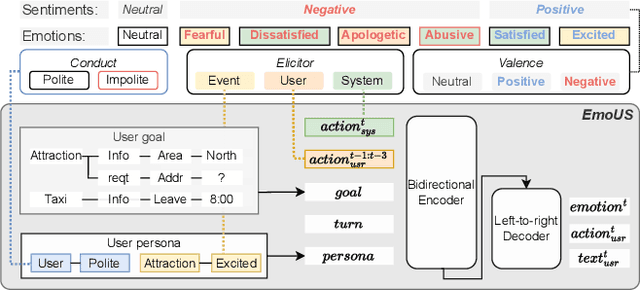
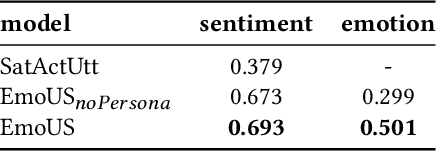


Abstract:Existing user simulators (USs) for task-oriented dialogue systems only model user behaviour on semantic and natural language levels without considering the user persona and emotions. Optimising dialogue systems with generic user policies, which cannot model diverse user behaviour driven by different emotional states, may result in a high drop-off rate when deployed in the real world. Thus, we present EmoUS, a user simulator that learns to simulate user emotions alongside user behaviour. EmoUS generates user emotions, semantic actions, and natural language responses based on the user goal, the dialogue history, and the user persona. By analysing what kind of system behaviour elicits what kind of user emotions, we show that EmoUS can be used as a probe to evaluate a variety of dialogue systems and in particular their effect on the user's emotional state. Developing such methods is important in the age of large language model chat-bots and rising ethical concerns.
 Add to Chrome
Add to Chrome Add to Firefox
Add to Firefox Add to Edge
Add to Edge